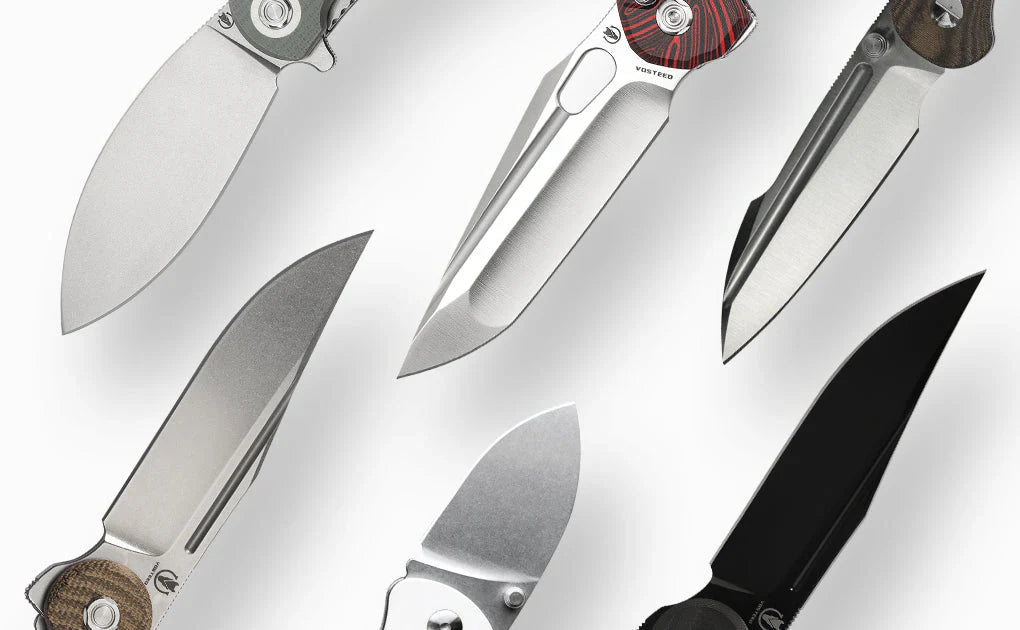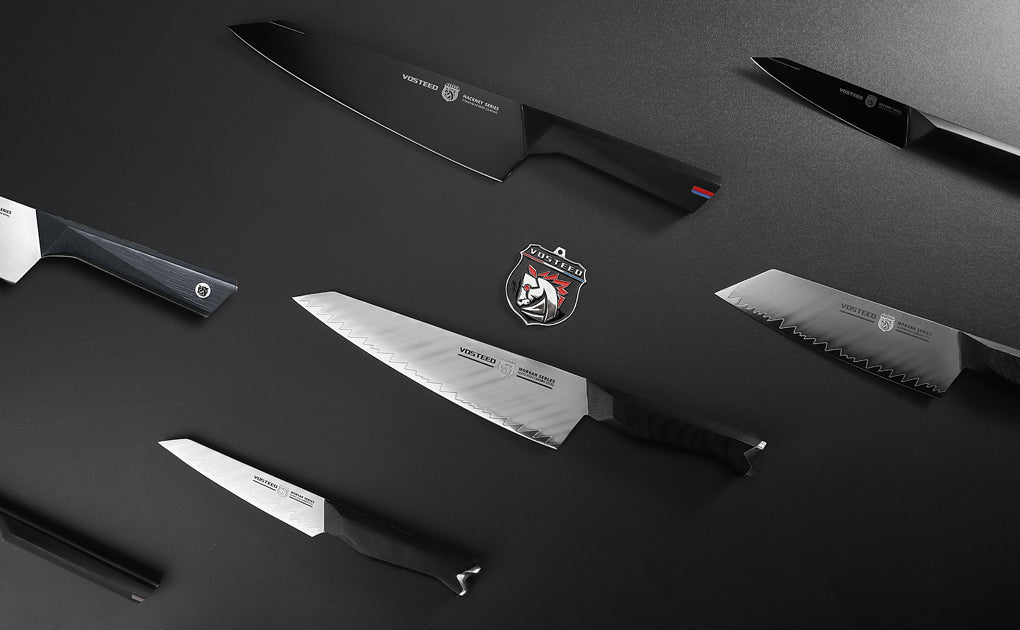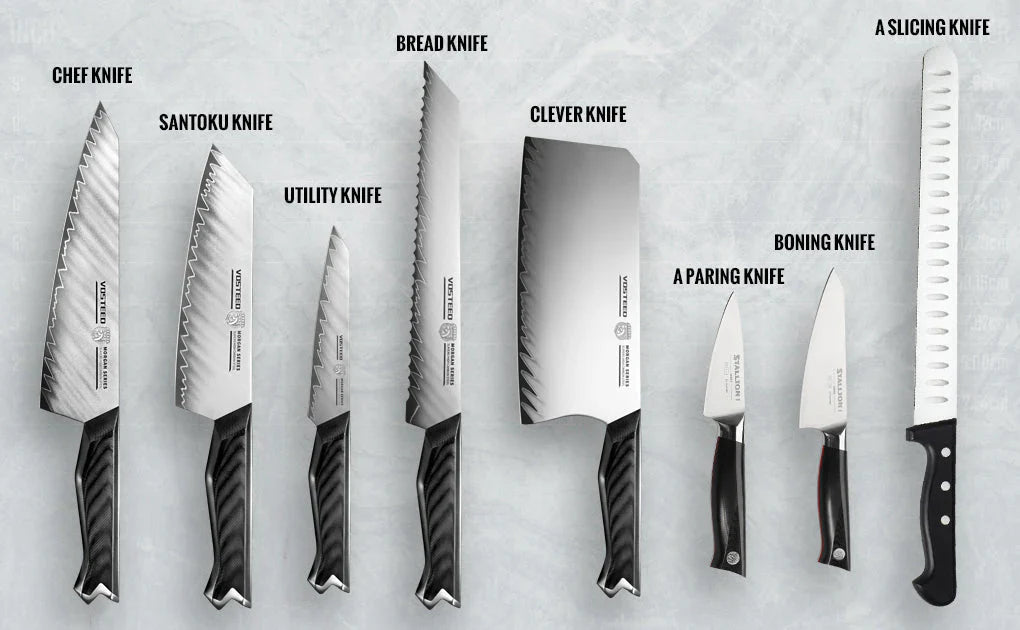Whether you are new to the knife world or a seasoned collector, understanding the different profiles of blades is key to choosing the right tool for the right job. The blade's profile—its overall shape—is the single most important factor that determines its function. While a beautifully crafted handle or an exotic blade steel might catch your eye, it's the geometry of the blade that dictates how it slices, pierces, and performs.
From versatile all-rounders perfect for everyday carry (EDC) to specialized shapes with rich historical roots, each profile offers a unique set of strengths and weaknesses. This guide will walk you through the most common blade profiles, helping you understand their design, intended uses, and what makes each one special. By the end, you'll be able to identify these shapes at a glance and confidently select the perfect knife for any task.
The All-Rounders: Handy Profiles for Everyday Use
These blade shapes are the workhorses of the knife world. Known for their versatility and balanced performance, they are excellent choices for EDC, outdoor adventures, and general utility tasks.
Drop Point
The Drop Point is arguably the most common and versatile blade profile available today. It's characterized by a convex spine that is curved downward, or "drops," to meet the tip. This creates a strong, easily controllable point and a large "belly" (the curved portion of the edge), which makes it a slicing superstar.
- Best For: Slicing, skinning, general utility, hunting, survival tasks.
- Key Feature: Strong tip and large slicing belly.
- Why You'll Love It: It’s a true jack-of-all-trades, capable of handling nearly any cutting chore you throw at it.

Clip Point
Instantly recognized and immensely popular in the EDC community, the Clip Point has a spine that looks like the front end of the blade has been "clipped" off. This can be a straight or concave clip, which creates a fine, sharp tip that excels at piercing and detail work.
- Best For: Piercing, precision tasks, stabbing.
- Key Feature: A very sharp but thinner tip.
- Heads Up: The fine tip is more delicate than a Drop Point's and can be prone to breaking under heavy stress.

Straight-Back Blade
Also known as a "Normal" or "Standard" profile, the Straight-Back is an ancient and trusted design. It possesses a straight back and curved edge that sweeps upward toward the point. With this shape, you are able to apply plenty of pressure along the spine for heavy chopping, making it a bushcraft favorite.
- Best For: Chopping, slicing, bushcraft, cutting rope.
- Key Feature: Strong spine for applying pressure and a durable tip.
- Why You'll Love It: Its classic design delivers reliable performance and excellent cutting power.

The Specialists: Profiles Designed for Specific Tasks
While the all-rounders manage to handle a range of tasks, these profiles are optimized to fit special use, from tactical operations to rescue operations.
4. Tanto
With a lineage tracing back to Japanese Samurai swords, the Tanto blade is built for strength. The Americanized Tanto, popular in tactical and military-style knives, features a high point with a flat grind, leading to an angular transition between the two cutting edges. This creates an exceptionally strong tip.
- Best For: Piercing tough materials, push cuts, light-duty prying.
- Key Feature: Extremely strong and durable tip.
- Heads Up: While powerful, it's not an all-purpose slicer, and sharpening the two distinct edges can be challenging for beginners.

5. Spear Point
A Spear Point blade is defined by its symmetrical profile, where both the spine and the edge curve to meet at a tip that is in line with the blade's centerline. This creates a very strong, balanced blade that is excellent for piercing. It can be single-edged or double-edged (in which case it's often called a dagger).
- Best For: Stabbing, piercing, self-defense.
- Key Feature: Symmetrical shape and strong tip.
- Why You'll Love It: Its inherent strength and balance make it a top choice for tactical knives.

6. Sheepsfoot
Originally designed for trimming sheep's hooves, the Sheepsfoot blade has a straight cutting edge and a dull spine that curves down to meet the tip. This design intentionally lacks a sharp point, making it difficult to accidentally pierce something. It's now a favorite among first responders and sailors.
- Best For: Slicing, rescue situations (cutting seatbelts), whittling.
- Key Feature: No sharp point, providing excellent control and safety.
- Why You'll Love It: Perfect for clean cuts where you need to avoid accidental punctures.

7. Wharncliffe
A close cousin to the Sheepsfoot, the Wharncliffe blade also has a perfectly straight cutting edge. However, its spine tapers down to the tip in a more gradual, continuous curve. This results in a fine, needle-like point, offering incredible precision for utility cuts.
- Best For: Utility cuts (like opening boxes), whittling, precision tasks.
- Key Feature: Straight edge and a fine, sharp tip.
- Why You'll Love It: It combines the slicing power of a razor blade with the precision of a fine point. Many modern EDC knives, like some Vosteed models, have adopted this versatile profile.

8. Cleaver
Evolved from the classic butcher's tool, the Cleaver has found surprising popularity in the EDC world. It's very similar to a Sheepsfoot with its straight edge and blunt front, but often features a wider, more robust blade. While it's not made for piercing, it's an exceptional chopper and slicer.
- Best For: Slicing, chopping, food prep, general EDC tasks.
- Key Feature: A wide, sturdy blade for powerful cuts.
- Why You'll Love It: Its unique look is backed by serious cutting capability.

Unique & Historical Profiles
These shapes have rich histories and distinct looks, often originating from specific cultures or for specialized uses that have since been adapted for modern needs.
9. Trailing Point
Also known as a Persian Point, the Trailing Point blade has a history that stretches back to 15th-century Iran. Its defining feature is a spine that curves upward to a very sharp, fine point that sits above the handle. This creates a massive belly, perfect for long, clean slices.

- Best For: Slicing, skinning, filleting.
- Key Feature: A large, curved belly for exceptional slicing.
- Heads Up: The tip, while very sharp, is relatively thin and can be fragile.
10. Kukri
Originating from Nepal and famously wielded by Gurkha soldiers, the Kukri has a distinct recurved blade that angles forward. This unique shape gives it incredible chopping power, making it both a formidable weapon and an invaluable agricultural tool for tasks like harvesting.
- Best For: Chopping, clearing brush, heavy-duty utility.
- Key Feature: Forward-weighted balance for powerful chopping.
- Why You'll Love It: There's nothing quite like a Kukri for raw chopping performance.

Leaf Shape
The Leaf Shape blade, as its name may indicate, bulges out to a broader belly before sharpening to a sharp, sturdy point. This configuration, encountered with the traditional Taiwanese Shilin Cutter, gives a deep belly for slashing and a heavy point. The blade is often just mildly recurved, which helps in "biting" into the material being cut.
- Best For: Work-oriented cutting, slicing, fishing tasks.
- Key Feature: Deep belly and a strong, usable tip.
- Why You'll Love It: It's an ergonomic and highly functional design for a wide range of cutting jobs.

Beyond the Classics: Understanding Modified Blade Shapes
As knife technology advances, manufacturers like to blend the characteristics of two or more profiles. You'll find such terms as "Modified Sheepsfoot" or "Modified Tanto" fairly often. These hybrids are intended to blend the best qualities of two or more classic shapes to create an even better cutting instrument. Don't be afraid to look at these strange shapes—many times they represent the forefront of knife technology.
Quick-Reference Blade Profile Guide
| Blade Profile | Primary Use | Strengths | Weaknesses |
| Drop Point | All-Purpose, Slicing | Strong tip, large belly, versatile | Less piercing power than a Clip Point |
| Clip Point | Piercing, Detail Work | Very sharp tip, good for precision | Tip can be fragile |
| Straight-Back | Chopping, Bushcraft | Durable, strong spine | Not ideal for piercing |
| Tanto | Piercing, Tactical | Extremely strong tip, durable | Not a great all-around slicer |
| Spear Point | Stabbing, Tactical | Very strong tip, balanced | Not ideal for general slicing |
| Sheepsfoot | Slicing, Rescue | Safe (no sharp point), clean cuts | Cannot pierce |
| Wharncliffe | Utility, Whittling | Extreme precision, straight edge | Tip can be delicate |
| Cleaver | Chopping, Slicing | Powerful, durable | Cannot pierce |
| Trailing Point | Slicing, Skinning | Excellent for long slices | Tip can be fragile |
| Kukri | Chopping | Immense chopping power | Unwieldy for small tasks |
| Leaf Shape | Work-oriented Cutting | Deep belly, strong tip | Can be specialized |
How to Choose the Right Blade Profile for Your Needs
After learning about the most common blade profiles, it is now time to consider your needs. Do you want an EDC knife that you can use to open letters and cut apples? A Wharncliffe, Drop Point. or Sheepsfoot would be an excellent choice. Heading into the woods on a camping trip? A Straight-Back or Drop Point will do fine. For those who need piercing power and tactical requirements, a Spear Point or Tanto might be the answer.
At Vosteed, we believe the right knife can make and simplify any task more enjoyable. The first step in finding that perfect tool is learning about blade profiles.





Leave a comment
All comments are moderated before being published.
This site is protected by hCaptcha and the hCaptcha Privacy Policy and Terms of Service apply.